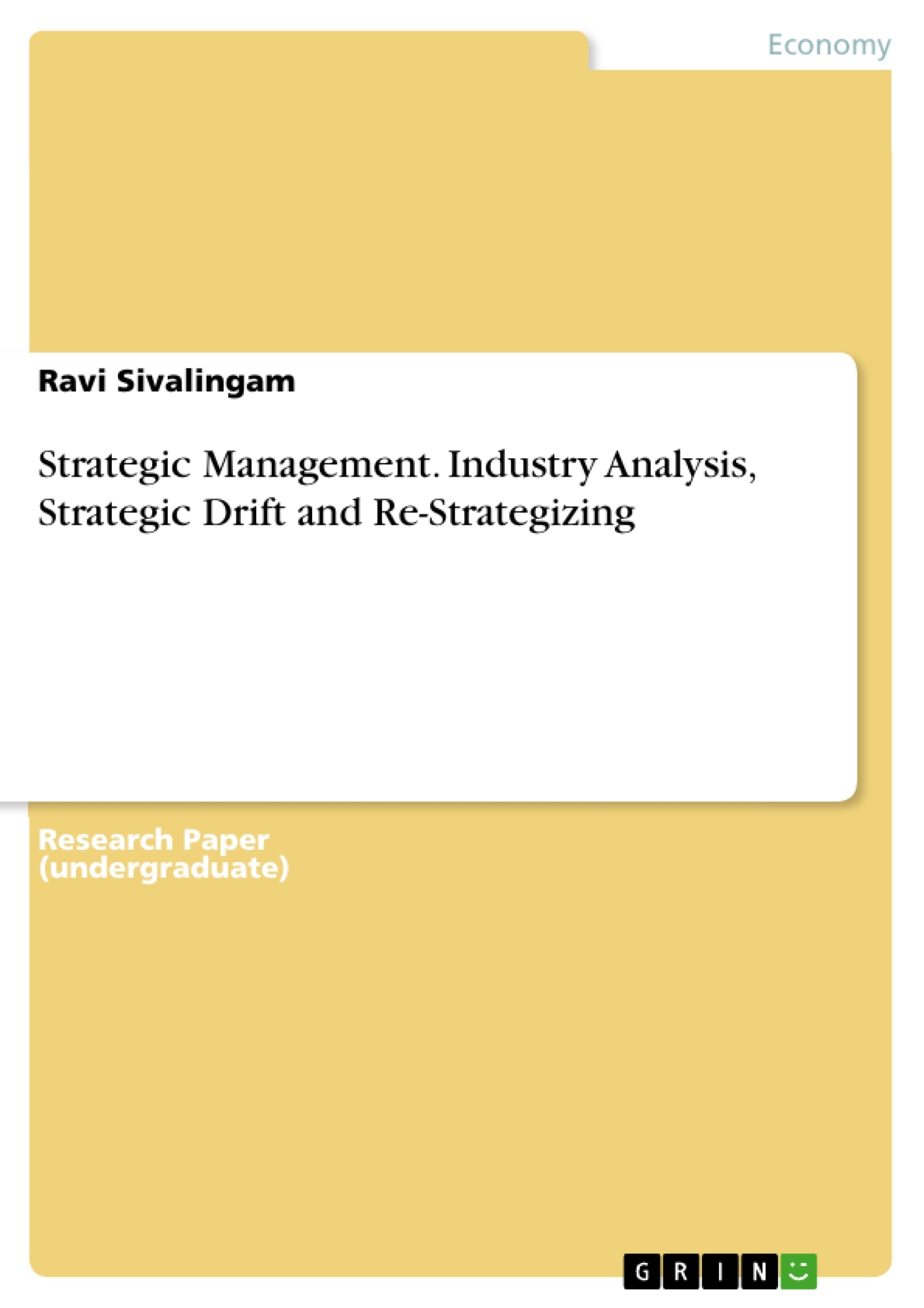This term paper deals with the strategic management of the company Marks and Spencer which has become a leading British retail icon since its conception more than a hundred years ago. The book deals in the first part with the company profile, the industry evolution, the current strategic position. The second part contains an industry analysis and market failures. It ends with re-strategizing.
Table of Contents
- 1. Company Profile
- 1.1 Industry Evolution
- 1.2 Current Strategic Position
- 2.0 Industry Analysis
- 2.1 PESTEL Analysis
- 2.2 Market Failures
- 2.2 Mintzberg's 5 Ps Concept
- 2.3 Risk Analysis
- 3.0 Strategic Drift
- 3.1 SWOT Analysis
- 3.2 Blue Ocean to Red Ocean
- 3.3 Sustainability
- 4.0 Re-Strategising
- 4.1 Strategic Objectives
- 4.2 Ansoff Matrix
- 5.0 Resource Management
Objectives and Key Themes
This report aims to analyze Marks & Spencer's (M&S) strategic management, focusing on its strategic direction towards market advancement. It examines the company's evolution within the retail industry, its current strategic position, and the challenges it faces in maintaining competitiveness. The analysis incorporates various strategic frameworks and tools to assess M&S's past decisions and future prospects.
- Industry evolution and competitive dynamics in the retail sector
- M&S's strategic positioning and response to market changes
- Analysis of M&S's strategic drift and its implications
- Evaluation of M&S's re-strategizing efforts and objectives
- Resource management and its role in achieving strategic goals
Chapter Summaries
1. Company Profile: This chapter provides a concise overview of Marks & Spencer, highlighting its history, size, and financial performance. It establishes M&S as a leading British retailer with a global presence, emphasizing its strong position in the UK market, particularly in women's wear and home products. The chapter also introduces the company's key strategic priorities, including sales growth, margin improvement, and strong cash generation, setting the stage for a deeper analysis of its strategic decisions and challenges.
1.1 Industry Evolution: This section delves into the complexities of the retail industry, emphasizing its diverse sectors and the need for product-category-specific strategies. It uses M&S's women's wear segment as a case study to illustrate the challenges of maintaining competitiveness in a mature market. The discussion highlights the impact of factors such as declining growth margins, intense price competition, and the need to balance cost reduction (e.g., importing from China) with maintaining brand quality and customer satisfaction. The section also touches upon supply chain management and intellectual property as crucial elements for successful navigation of the evolving retail landscape.
1.2 Current Strategic Position: This section examines M&S's strategic shift towards sustainability in 2012 as a response to declining revenues. It details the "Plan A" initiative, focusing on its various aspects, including sustainable sourcing, garment reuse, charity work, and promotion of social equality. This chapter also analyzes the company's loyalty program ("SPARKS") as a strategy to recapture lost customers. The section highlights the trade-offs between cost reduction (e.g., shifting sourcing to China) and maintaining brand image, revealing the complexities of balancing financial performance with brand loyalty and customer perception.
Keywords
Strategic management, retail industry, Marks & Spencer, competitive advantage, sustainability, industry evolution, strategic drift, re-strategizing, resource management, market analysis, SWOT analysis, Ansoff matrix, brand image, customer loyalty, supply chain management.
Marks & Spencer Strategic Management Report: Frequently Asked Questions
What is the purpose of this report?
This report comprehensively analyzes Marks & Spencer's (M&S) strategic management, focusing on its strategic direction and efforts towards market advancement. It examines the company's evolution within the retail industry, its current position, and the challenges it faces in maintaining competitiveness.
What topics are covered in the report?
The report covers a wide range of topics, including M&S's company profile, industry analysis (PESTEL, Mintzberg's 5 Ps, risk analysis), strategic drift (SWOT analysis, Blue Ocean/Red Ocean strategy, sustainability), re-strategizing (strategic objectives, Ansoff matrix), and resource management. Specific case studies are used, such as M&S's "Plan A" sustainability initiative and its "SPARKS" loyalty program.
What key themes are explored in the analysis?
Key themes include industry evolution and competitive dynamics in the retail sector; M&S's strategic positioning and response to market changes; analysis of strategic drift and its implications; evaluation of re-strategizing efforts and objectives; and the role of resource management in achieving strategic goals. The report also addresses the complexities of balancing cost reduction with brand image and customer loyalty.
What strategic frameworks and tools are used in the analysis?
The report employs various strategic frameworks and tools, including PESTEL analysis, Mintzberg's 5 Ps, SWOT analysis, the Ansoff matrix, and an examination of Blue Ocean and Red Ocean strategies. These tools are used to assess M&S's past decisions and predict future prospects.
What specific aspects of M&S are analyzed in detail?
The report analyzes M&S's "Plan A" sustainability initiative, its "SPARKS" loyalty program, its strategic shift towards sustainability in 2012, and the complexities of balancing cost reduction (such as sourcing from China) with maintaining brand quality and customer satisfaction. The women's wear segment is used as a case study to illustrate challenges in a mature market.
What are the key takeaways or conclusions of the report?
The report offers a detailed assessment of M&S's strategic journey, highlighting both its successes and challenges. It demonstrates the need for adapting to the changing retail landscape while balancing financial performance with brand loyalty and customer perception. The analysis of various strategic tools and frameworks provides insights into the company's past decisions and potential future directions.
What are the keywords associated with this report?
Strategic management, retail industry, Marks & Spencer, competitive advantage, sustainability, industry evolution, strategic drift, re-strategizing, resource management, market analysis, SWOT analysis, Ansoff matrix, brand image, customer loyalty, supply chain management.
- Quote paper
- Ravi Sivalingam (Author), 2015, Strategic Management. Industry Analysis, Strategic Drift and Re-Strategizing, Munich, GRIN Verlag, https://www.grin.com/document/415823




